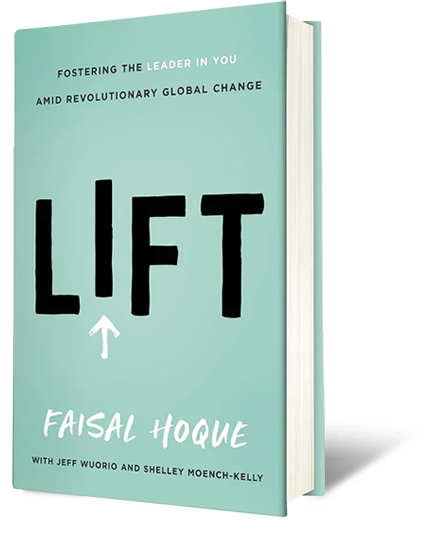The world is undergoing a global, nonstop maelstrom of change and, while stressful by its very nature, is necessary for growth, progress, and human evolution.
 The Fourth Industrial Revolution (4IR) affects all areas of our lives, including individuals, businesses, education, and health care. We still don’t know the full effects of this reach, but it is life-changing, for sure.
The Fourth Industrial Revolution (4IR) affects all areas of our lives, including individuals, businesses, education, and health care. We still don’t know the full effects of this reach, but it is life-changing, for sure.
As individuals become leaders in their own right, they become empowered to make decisions, adapt to the changing environment around us, and serve as catalysts for pervasive change for the better. If there’s a single word that encapsulates the opportunity afforded to these individual leaders, it might well be consumer. No matter if it’s related to work, health care, or varied forms of collective, community involvement, the individual has been moved to the powerful role of consumer—the end user who wields the capacity and influence to impact and transform.
With regard to work, individuals will have increasing opportunities to leverage technology and shifting managerial priorities to gain more varied training and work experience. Through revisiting and adopting new organizational principles, individuals will also have access to different work experiences and the opportunity to accumulate a broader array of marketable skills.
While companies may deem the pandemic a hard pill to swallow because they’re used to closely monitoring employees in-house, in reality it has given employees the opportunity to potentially become more productive. According to Great Place to Work, 5 percent of American employees worked from home pre-pandemic, but by May 2020, more than 60 percent were working remotely.
And that group working in varied alternate settings has made the most of their time, according to a study by Stanford University of some 16,000 workers whose productivity when working from home increased by 13 percent. The studyattributed the boost to a quieter work environment and fewer breaks and days lost to illness.
Individual empowerment goes well beyond professional development and productivity. Individuals will also have the opportunity to approach work-life balance in a completely different context—incorporating a much more blended and interactive perspective. In particular, remote work opportunities will afford social and familial benefits that often were limited in “traditional” workplace logistics. Again, as leaders, they will have the freedom and ability to craft the sort of mix of work and play that they wish and best fits their personal and professional needs.
The drivers of change are [also] opening up significant new opportunities for businesses—opportunities that are not necessarily focused exclusively on the bottom line and with potentially greater import than any profit and loss statement.
One such example lies in lowered business expenses. Be it through need for less office space, equipment, travel expenses, and other associated operating costs, businesses are poised to pocket significant savings by decreases in the protocols and necessities of what was formerly “business as usual.” In fact, one company can save more than $10,000 for each remote worker who telecommutes to work 50 percent of the time, according to Global Workplace Analytics Telework Savings Calculator. Obviously enough, those saved funds could go elsewhere, from increased employee benefits to expanded public outreach, which is becoming critical amid shifting consumer interests and priorities.
Another plus is increased access to applicants, particularly well-qualified ones. A company that is open to remote work arrangements not only may boost the number of applicants it can consider—since location is now less of a consideration—but also stands to attract applicants for whom remote work arrangements is an enticing, if not somewhat mandatory, benefit.
Still another plus for businesses is the experience and training that more autonomous work arrangements can provide. Workers who are now self-managing to a larger extent are almost certainly acquiring greater and more varied skill sets, such as time management, decision-making, and other positive abilities.
A third benefactor of 4IR is education. On a global level, education has the opportunity to recraft what education genuinely means. Going back for countless generations, education has had an inherent emphasis on “training”—imbuing students with sufficient skills to become productive members of the workforce and little else. Even after the ultimate destinations for many of these students—for instance, factories and mills—largely disappeared, education has yet to completely pivot away from the goal of molding young people with sufficient basic skills and education to perform rudimentary work tasks.
If nothing else, that clearly mandates a shift away from traditional learning to more sophisticated material and methodology that will equip students to work effectively with the varied new forms of technology they will inevitably encounter. That lies, in part, in needed improvements to elements of STEM curricula (science, technology, engineering, and math), in addition to other adaptations and revisions in other areas of learning.
These varied opportunities also clearly suggest that teachers will have to change as well. Education at all levels has an opening to recraft education into a more personal, individualized, and self-directed approach. For one thing, a more informed and technologically savvy student population will be able to have more control over what and how they learn. Teachers will increasingly adopt the role of mentors rather than instructors serving up information that students merely memorize, guiding students through more individual and autonomous processes of inquiry and research.
Finally, drivers such as the Fourth Industrial Revolution and the COVID-19 pandemic have positioned health care in its varied permutations to shift its focus to a more unified, proactive, and cost-effective model. And, once again, the consumer is increasingly at the heart of change, particularly with regard to ready access to comprehensive individual health information. Easily shared data, artificial intelligence (AI), and open, secure platforms will continue to merge to create a multilayered and highly specific view of patients’ overall well-being and health—one that they can have access to when and how they wish.
That newfound level of individual access and involvement reflects a particularly expansive adoption of technology. Although medicine and health care stand to benefit enormously from technological innovations regarding research and patient treatment, the advantages are not exclusively internal. Rather, as one analysis points out, digital solutions “have the most impact when they extend beyond the walls of an organization and encompass more of its end-to-end value chain”—in other words, making the patient as consumer a cornerstone of a shifting industry.
The world is undergoing a global, nonstop maelstrom of change and, while stressful by its very nature, is necessary for growth, progress, and human evolution. Learning to take one step at a time will help you evolve toward a more productive, balanced, lifted existence.
Excerpt from Faisal Hoque’s forthcoming book “Lift: Fostering the Leader in You Amid Revolutionary Global Change“. Copyright 2022 by Faisal Hoque. All rights reserved.
[Photo by JOHN TOWNER on Unsplash]















